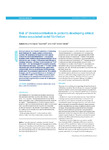Risk of thromboembolism in patients developing critical illness-associated atrial fibrillation
| dc.contributor.author | Clayton, B | |
| dc.contributor.author | Ball, S | |
| dc.contributor.author | Read, J | |
| dc.contributor.author | Waddy, S | |
| dc.date.accessioned | 2023-02-20T12:02:59Z | |
| dc.date.available | 2023-02-20T12:02:59Z | |
| dc.date.issued | 2018-08 | |
| dc.identifier.issn | 1470-2118 | |
| dc.identifier.issn | 1473-4893 | |
| dc.identifier.uri | http://hdl.handle.net/10026.1/20456 | |
| dc.description.abstract |
Although common, the long-term significance of -developing atrial fibrillation (AF) during a period of critical illness is unclear. We undertook a retrospective cohort analysis to -assess the rate of thromboembolism (TE) in patients -developing atrial fibrillation de novo during admission to our intensive care unit. In total, 1,955 patients were followed up (-maximum follow-up 1,276 days) for the occurrence of TE, of which 220 (11.3%) had developed AF or atrial flutter during their critical care admission. There were 11 TE events among the patients with new AF (0.053 events per patient-year), compared with 18 in the non-AF group (0.0059 events per patient-year). The unadjusted hazard ratio for TE in patients developing new AF compared with those not developing AF was 8.09 (95% CI 3.08-17.19, p<0.001). In patients admitted to critical care, the development of AF appears to be associated with a significantly increased risk of subsequent thromboembolism. | |
| dc.format.extent | 282-287 | |
| dc.format.medium | ||
| dc.language | en | |
| dc.language.iso | eng | |
| dc.publisher | Royal College of Physicians | |
| dc.subject | Atrial fibrillation | |
| dc.subject | critical care | |
| dc.subject | critical illness | |
| dc.subject | intensive care | |
| dc.subject | stroke | |
| dc.subject | thromboembolism | |
| dc.subject | Aged | |
| dc.subject | Aged, 80 and over | |
| dc.subject | Atrial Fibrillation | |
| dc.subject | Critical Illness | |
| dc.subject | Female | |
| dc.subject | Humans | |
| dc.subject | Kaplan-Meier Estimate | |
| dc.subject | Male | |
| dc.subject | Middle Aged | |
| dc.subject | Retrospective Studies | |
| dc.subject | Risk Factors | |
| dc.subject | Stroke | |
| dc.subject | Thromboembolism | |
| dc.subject | United Kingdom | |
| dc.title | Risk of thromboembolism in patients developing critical illness-associated atrial fibrillation | |
| dc.type | journal-article | |
| dc.type | Journal Article | |
| plymouth.author-url | https://www.ncbi.nlm.nih.gov/pubmed/30072549 | |
| plymouth.issue | 4 | |
| plymouth.volume | 18 | |
| plymouth.publication-status | Published | |
| plymouth.journal | Clinical Medicine | |
| dc.identifier.doi | 10.7861/clinmedicine.18-4-282 | |
| plymouth.organisational-group | /Plymouth | |
| plymouth.organisational-group | /Plymouth/Faculty of Health | |
| plymouth.organisational-group | /Plymouth/Users by role | |
| plymouth.organisational-group | /Plymouth/Users by role/Academics | |
| plymouth.organisational-group | /Plymouth/Users by role/Post-Graduate Research Students | |
| dc.publisher.place | England | |
| dcterms.dateAccepted | 2018-01-01 | |
| dc.rights.embargodate | 2023-2-23 | |
| dc.identifier.eissn | 1473-4893 | |
| dc.rights.embargoperiod | Not known | |
| rioxxterms.versionofrecord | 10.7861/clinmedicine.18-4-282 | |
| rioxxterms.licenseref.uri | http://www.rioxx.net/licenses/all-rights-reserved | |
| rioxxterms.type | Journal Article/Review |


